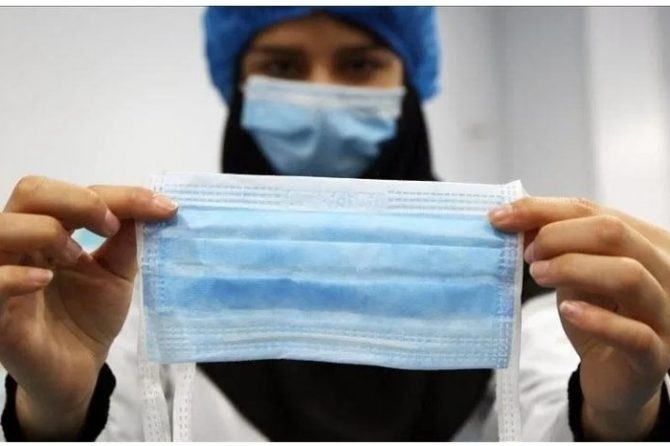
Wearing masks in public places where it is not possible to maintain physical distance, such as public transportation, grocery stores, or even the workplace, could help reduce the spread of the SARS-CoV-2 virus. Masks can raise awareness of physical distance and health-conscious behavior.
1. Face masks
Face masks are, in the broadest sense, masks that are made from commercially available two-layer cotton materials of denser weave and are worn in everyday life. For optimal effectiveness, the two-layer cotton textile face mask, which acts as a textile barrier, should be worn properly (ie put it firmly on the nose and mouth), changed if it is moisturized due to breathing and not touched while worn. >
Instructions for manufacturers
The declaration must state the raw material composition and maintenance instructions, and when describing or complaining about the mask, care must be taken not to create the impression that it is a medical product or protective equipment. It is recommended to make face masks from two-layer cotton materials of denser weave.
Instructions for handling face masks
The best protection against possible transmission of the virus is to maintain a safe physical distance from other people who are potentially infected with the virus. Nevertheless, the physical barrier created by wearing a face mask properly can provide some protection against larger droplets, which can contain the virus, and prevent the mouth / nose from touching dirty hands. Such masks can, like other textile items, slow down the flow of exhaled air or the transmission of respiratory droplets and increase people's awareness of the need for physical distance as well as more careful treatment of themselves and others to protect their own and others' health. In this way, it can contribute to reducing the further spread of SARS-CoV-2 virus, and in this context, cotton double-layer dense fabric is more suitable for making face masks.
People wearing a face mask should strictly adhere to the following rules:
Masks must be used for personal use only.
It is necessary to continue to adhere to all prescribed hygiene measures, indicated in the recommendations of the PHI of Sarajevo Canton.
Even when wearing a face mask, it is necessary to maintain a distance between people of 2 m according to the WHO recommendation.
When applying the mask, care should be taken to always put the inside of the mask next to the face.
One mask is worn by only one person, worn masks must not be shared with other people.
Before using the mask for the first time, it is advisable to wash or at least iron it with an iron set to the temperature for ironing cotton / linen materials.
Wash your hands thoroughly with soap before and after applying the mask.
The mask should cover the mouth, nose and part of the face, and at the edge it should adhere tightly to minimize the flow of air outside the mask when exhaling.
When using for the first time, make sure that the mask is leaking enough air to prevent normal breathing.
The moistened mask should be removed and replaced with a new, dry one.
A virus can potentially be found on the outside of the mask. To prevent contamination of the hands, touching the outside of the mask should be avoided.
After removing the mask, it should be put in a bag and sealed well or washed immediately. To prevent the appearance of mold, it is not recommended to keep the mask closed for a long time after wearing it.
The masks should be washed at 95 degrees, and at least at 60 degrees, and dried well after one wear.
If there are manufacturer's instructions, they must be followed in full.
2. Medical masks (surgical masks)
Medical / surgical masks are primarily used to protect other people from exposure to potentially infectious droplets from the person wearing the mask. Their application is one-time. A suitable mask also to some extent protects the user of the mask when it is firmly attached. They are used primarily for medical purposes and serve to prevent the spread of droplets from exhaled air to the patient or another person and can protect the mouth and nose from the direct impact of larger drops of another person and from the transmission of pathogens by direct contact with hands. Non-sterile medical masks are usually risk-class medical devices in accordance with the European Directive on Medical Devices (93/42 / EEC) and in particular must comply with standard EN 14683: 2019-6. Following the conformity assessment procedure, they are awarded the "CE" marking, which allows them to be placed on the European market.
3. Filter half masks with and without valve (FFP2 and FFP3)
Filter half masks (FFP) are considered personal protective equipment (PPE) in the context of occupational safety and are intended for protection against particles, droplets and aerosols, primarily in health care facilities. Their application is one-time. The design of filter masks is different. There are masks without an exhalation valve and masks with an exhalation valve. Valveless masks filter inhaled air and exhaled air and therefore provide both self-protection and external protection. Valve masks filter only the inhaled air and therefore provide self-protection.
In order for FFP masks to be placed on the market in Europe, they must undergo a conformity assessment procedure in accordance with the European regulation EU2016 / 425, after which they receive the “CE” mark. Masks must also meet the requirements of the European standard EN 149: 2001-10
By way of derogation, in exceptional cases FFP masks can also be considered as medical devices if they do not have an exhalation valve (i.e. air is filtered during inhalation and exhalation). Such masks are worn in situations where it is known to provide immediate medical care to an infected person, in procedures in which an aerosol is generated because they stop 95% and more, or 98% or more particles, depending on the strength of the filtration.
Recommendations for the use of face masks, medical and protective masks




